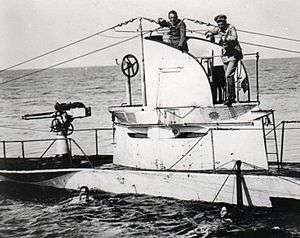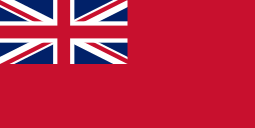SM U-27 (Germany)
SM U-27 was a German Type U-27 U-boat built for service in the Imperial German Navy. She was launched on 14 July 1913, and commissioned on 8 May 1914 with Kapitänleutnant Bernd Wegener in command.
 German U-boat U-27 with crew | |
| History | |
|---|---|
| Name: | U-27 |
| Ordered: | 19 February 1912 |
| Builder: | Kaiserliche Werft Danzig |
| Launched: | 14 July 1913 |
| Commissioned: | 8 May 1914 |
| Fate: | Sunk 19 August 1915 in Western Approaches. 37 dead. |
| General characteristics [1] | |
| Class and type: | German Type U 27 submarine |
| Displacement: |
|
| Length: | 64.70 m (212 ft 3 in) (o/a) |
| Beam: | 6.32 m (20 ft 9 in) |
| Draught: | 3.48 m (11 ft 5 in) |
| Speed: |
|
| Range: |
|
| Test depth: | 50 m (164 ft) |
| Complement: | 4 officers, 31 enlisted |
| Armament: |
|
| Service record | |
| Part of: |
|
| Commanders: |
|
| Operations: | 3 patrols |
| Victories: |
|
On 18 October 1914, the British submarine HMS E3 was torpedoed and sunk in the North Sea by U-27. This was the first action in which one submarine sank another.
Sinking of HMS E3
HMS E3 had sailed from Harwich on 16 October to patrol off Borkum in the North Sea. On 18 October, E3 spotted some German destroyers ahead but was unable to get into a position to take a shot at them. Unable to pass them, Commander Cholmley retreated into the bay to wait for them to disperse. As he did so, he failed to see that the bay was also occupied by U-27, under Kapitänleutnant Bernd Wegener.
Wegener was surfaced and patrolling between the Ems and Borkum when at 11:25, an object resembling a buoy was spotted where no buoy should be. Suspecting a British submarine, U-27 immediately dived and closed the object. Although the enemy was ‘conned down’, the number 83 was clearly visible on the conning tower of the British boat, now identified as such beyond reasonable doubt. Wegener tracked the submarine for two hours until able to approach ‘up sun’. He noted that the look-outs were staring intently in the other direction, towards the Ems. When the distance had closed to 300 m (330 yd), U-27 fired two G6 torpedoes. An explosion 12 seconds later sank E3 immediately. The KTB records that men (probably the look-outs from the bridge) were visible in the water but U-27 dived and withdrew, fearful that a second British submarine might be lurking nearby. 30 minutes later, the U-boat returned to the scene to search for evidence and possible survivors but without success. All 28 members of E3's crew were lost.
Other encounters
- 31 October 1914, U-27 sank the seaplane carrier HMS Hermes in the Straits of Dover, in position 51°06.3′N 001°50.3′E.[2]
- 11 March 1915, U-27 sank the armed merchant cruiser HMS Bayano off Carswell Point, Stranraer at position 55°3′N 5°26′W.[3]
- 18 May 1915 – Drumcree (

- 19 May 1915 – Dumfries (

Sinking and Massacre of the Survivors
On 19 August 1915, U-27 was sunk in the Western Approaches in position 50°43′N 07°22′W by gunfire from Q-Ship HMS Baralong, which had been using a neutral American flag as a false flag. After the sinking of U-27, the surviving crew, including Bernd Wegener, were shot in the water and aboard the SS Nicosian, aboard which several survivors had climbed. The Commander of HMS Baralong had received secret orders from the Admiralty to "take no prisoners from U-boats."
The massacre of U-27's crew violated the Hague Convention, which defines the killing of unarmed shipwreck survivors as a war crime. The testimony of American sailors who had witnessed the massacre, caused an international incident.
The British Government's refusal to court martial the perpetrators of the massacre caused the Imperial German Government to adopt a policy of unrestricted submarine warfare.
Instead of surfacing and boarding Allied merchant ships, U-boats began to torpedo them on sight. Many U-boat commanders cited the Baralong incidents and said, "It's their lives or ours. No warning."
This policy ultimately caused the United States to abandon its neutrality and declare war on Imperial German in May 1917.
Summary of raiding history
| Date | Name | Nationality | Tonnage[Note 1] | Fate[6] |
|---|---|---|---|---|
| 18 October 1914 | HMS E3 | 725 | Sunk | |
| 31 October 1914 | HMS Hermes | 5,600 | Sunk | |
| 11 March 1915 | HMS Bayano | 5,948 | Sunk | |
| 13 March 1915 | Hartdale | 3,839 | Sunk | |
| 18 May 1915 | Drumcree | 4,052 | Sunk | |
| 19 May 1915 | Dumfries | 4,121 | Sunk | |
| 21 May 1915 | Glenholm | 1,968 | Sunk | |
| 18 August 1915 | Ben Vrackie | 3,908 | Sunk | |
| 18 August 1915 | Gladiator | 3,359 | Sunk | |
| 18 August 1915 | Magda | 1,063 | Sunk | |
| 18 August 1915 | Sverresborg | 1,144 | Sunk | |
| 19 August 1915 | Peña Castillo | 1,718 | Sunk |
References
Notes
- Merchant ship tonnages are in gross register tons. Military vessels are listed by tons displacement.
Citations
- Gröner 1991, pp. 6-7.
- HMS Hermes at www.wrecksite.eu
- "Record for HMS Bayano". Royal Commission on the Ancient and Historical Monuments of Scotland. 19 June 2007. Retrieved 15 June 2009.
- Lettens, Jan. "SS Drumcree [+1915]". wrecksite. Retrieved 10 April 2012.
- Lettens, Jan. "SS Dumfries [+1915]". wrecksite. Retrieved 10 April 2012.
- Helgason, Guðmundur. "Ships hit by U 27". German and Austrian U-boats of World War I - Kaiserliche Marine - Uboat.net. Retrieved 22 December 2014.
Bibliography
- Gröner, Erich; Jung, Dieter; Maass, Martin (1991). U-boats and Mine Warfare Vessels. German Warships 1815–1945. 2. Translated by Thomas, Keith; Magowan, Rachel. London: Conway Maritime Press. ISBN 0-85177-593-4.
| Wikimedia Commons has media related to German Type U 27 submarine. |